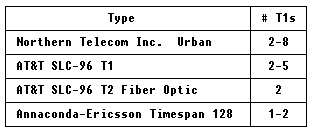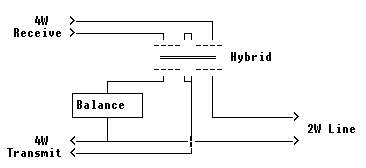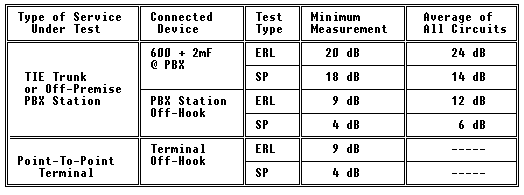| RETURN | Voice Networking |
Two and Four Wire Transmission
The following sections discuss the 2-Wire line, and typical 2-Wire implementations within the PSTN. Also discussed is the ‘Hybrid’, a device used to provide 2-Wire to 4-Wire conversions.
2-Wire Line Implementation Within The PSTN
2-Wire loss (End User POT – EO) can be anywhere from 0 dB to 8.5 dB. Usually, the engineered 2-Wire loss will be in the objective range of 4 to 6 dB. As per a 1980 survey, 4% of subscriber loops had losses greater than 8.5 dB, and 2% of subscriber loops exceeded 10 dB.
While the impedance of the telephone is 600 ohms, the impedance of the line is complex, and will rarely match it, due to the cable characteristics, repeater use, etc.
Usually the total IMPEDANCE of a typical EO POTS line EXCEEDS 900 OHMS (1 Kohm and above). Therefore, many Central Office HYBRID ALIGNMENTS ARE PERFORMED USING 900 OHM TERMINATIONS with capacitance.
CUSTOMER PBX SYSTEMS TYPICALLY HAVE RELATIVELY SMALL TELEPHONE CABLE LENGTHS. THEREFORE, PBX LINE ADJUSTMENTS SHOULD BE PERFORMED USING 600 OHM IMPEDANCES.
The Physical Loop Connection
The physical loop connections from the End User Point Of Termination are provided by the Local Exchange Carriers (LECs) and thusly, regulated by the State’s Public Service Commission (PSC) or Public Utilities Commission (PUC).
Cable Connectivity
Most commonly, cables are routed over poles. These telephone pole structures vary depending upon the load, weather factors, and terrain factors.
Typical practice for rural or suburban areas is to utilize buried cables. The depth of these cables is usually betwen 2 and 4 feet, depending upon location, regulatory requirements, future requirements, etc. These cables have a special waterproof filling with splicing taking place in the ground, or in above-ground pedestals.
In more congested areas, cables are run in conduit, with manholes used for splicing. Conduit uses a specific heirarchy:
- Main conduits provide interconnective and protection for "feeder"
sections of the plant.
- Subsidiary conduits link the "feeder" route to a particular customer
location or distribution facility.
- Branch conduit links the underground feeder route to aerial (pole) or
buried cable to a single, or group of, building(s).
The length of the conduit is dependent upon many variables, such as location of intersecting conduit/cables, repeater requirements, physical routing requirements, and pulling tension. Typically, plastic conduit has a lower coefficient of friction than concrete or fiberglass conduit, therefore it can support longer cable pulls (‘runs’).
The advantage of conduit is the ability to rerun cables (e.g. replace copper wiring with fiber optic cables, etc.).
Submarine cable is used where land routing is not pratical or possible. Protective materials are placed around the cable, especially in shallow water. Clamps anchor the cable from the action of currents.
Digital Loop Carrier (DLC)
Digital Loop Carrier (DLC) systems were introduced in the 1970s as an efficient way to provide service to a customer, since many more users can be supported over the same amount of wire pairs.
DLC systems are T-carrier based, mutiplexing 24 64 KBPS DS0 channels into T1 lines. The basic architecture consists of a Central Office Terminal (COT), a T1 transmission facility (e.g. cable), and a Remote Terminal (RT). These systems also facilitate Central Office diagnostics and offer redundancy and automatic switching functions upon failures.
Listed below are some of the presently used DLC systems:

The “Hybrid” TransformerIt is not possible to extend, through a telecommunications network, a 2-wire telephone circuit. Therefore, special 2-Wire to 4-Wire converters, known as ‘hybrids’ provide the conversion to the 4-Wire facilities required.
A basic hybrid contains two transformers and four specific windings: 2-Wire line, 4-Wire Transmit, 4-Wire Receive, and a Balance (or, ‘Compromise’) Network.

Generally, signals input to the hybrid on the 4W Receive leg of the circuit can be fed back to the 4W Transmit. THESE SIGNALS RETURN AS ‘ECHO’. The balance network however, can provide some adjustments such that the signals from the two transformer sections cancel each other out, negating the echo.
THE IMPEDANCE OF THE 2-WIRE LINE DEPENDS UPON THE LENGTH AND WIRE TYPE. Additionally, the only time a 2-Wire circuit has a hybrid switched into it is when a call is placed over it to a remote area phone (e.g. most local connections are 2-Wire). The switching of hybrids also means that different 2-Wire lines and Hybrids will be matched up for each call, making precise balance difficult, since each hybrid and 2-Wire line will have different characteristics.
It is for this reason that the balancing network is sometimes referred to as a Compromise Balance Network; that a happy medium of adjustment is achieved for most circuit connections. ATT Pub 43101 specifies Echo Return Loss (ERL) and Singing Point (SP) values that are listed in the following table:
